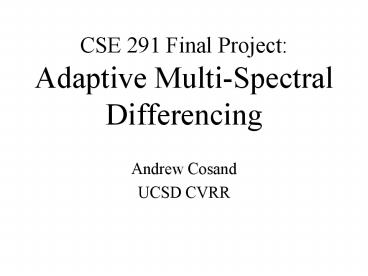CSE 291 Final Project: Adaptive MultiSpectral Differencing PowerPoint PPT Presentation
Title: CSE 291 Final Project: Adaptive MultiSpectral Differencing
1
CSE 291 Final ProjectAdaptive Multi-Spectral
Differencing
- Andrew Cosand
- UCSD CVRR
2
Differencing
- Detect changes in a sequence of images.
- Pixels of reference image are subtracted from the
current image to determine how different they
are. - Pixels with exceed some difference threshold are
assumed to correspond to different objects in the
images.
3
Differencing
Reference Image Current Image Difference
4
Problems
- Differences other than the object of interest may
show up. - Pixel noise
- Moving background objects (trees, water)
- Lighting changes
- Camera movement (small)
- Shadows Reflections
5
Pixel Noise
6
Solutions
- Variations can be included in a background model.
- Reference frame may use eg Gaussian mixture
models to characterize pixels - Reference frame can be updated at different
rates. Very slow basically detects changes from
when the system was started, very fast detects
changes from the previous frame.
7
Camera Movement
8
Solutions
- Very small camera movements can be modeled in the
background similar to pixel noise or moving
background objects - Other segmentation methods can be used to
identify and track objects in the scene - Camera motion can be identified and corrected
(Optical flow, correspondence)
9
Shadows
Detected Difference
Good
Bad
Shadow
10
Solutions
- Color Space Conversion
- Transform data into more useful form, eg
normalized chromaticity or Hue Saturation
Intensity colorspace, which separates color and
intensity for robust detection in the presence of
shadows.
11
HSI
- Hue angle determines color
- Saturation determines how colorful or washed
out - Intensity determines brightness
12
HIS Colorspace Detection
- Shadows simply decrease intensity without
effecting hue - Hue differencing is therefore quite robust to the
presence of shadows - Great
- But.
13
Hue Determination
- To decide what color a pixel is, it must first
have a color - Conversion
- Normalize R,G,B s.t. 0 ? r,g,b ? 1
- h acos (r-g)(r-b)
- 2(r-g)2 (r-b)(g-b)1/2
- Very sensitive when r ? g ? b
14
Hue Differencing
Hue Noise Causes False Detects
15
Idea
- Since hue information is unreliable for grayish
pixels, ignore hue difference results at these
pixels and use intensity instead. - Need some weighting function which determines how
to do this.
16
Previous Solution
- Francois and Medioni used a saturation threshold
to ignore hue information for gray pixels - Works well
- Requires threshold to be set
17
Goal
- Want a weighting function which will specify a
combination of hue and intensity differencing. - Intensity should receive more weight when hue is
unreliable - Hue should receive more weight when it can be
reliably determined - Hope to find some underlying relationship
18
Implementation
- Using Euclidian distance to gray line as a color
measure - Saturation is somewhat tricky (a la Matlab)
- Ideal system would determine weighting function
based on training data, similar to backpropogation
19
Backpropogation
- Outputs are weighted combinations of inputs
- Determine errors at outputs
- Determine how much each input was responsible for
the error - Adjust each weight accordingly
20
Current Algorithm
- Examines each pixel, changes weight in proportion
to the error - For pixels which should have detected, weight is
increased proportionally to 1-detection - For pixels which should NOT have detected, weight
is DECREASED proportionally to detection
21
Insights
- Examination of hue errors shows a definite
correlation to coloration
22
Results Weighting Functions
23
Lack of Colorful Data
24
Results Combined Detection
25
Problems
- Correlation can vary widely from image to image.
- Weights are noisy, skewed by lack of colorful
data - Probably needs more data processing
- No good model determined yet
26
Conclusion
- System shows definite promise
- Model still needs to be determined and adaptively
fit
27
Shadow Supression
28
References
- A.R.J. Francois, G.G. Medioni, Adaptive Color
Background Modeling for Real-Time Segmentation of
Video Streams - A. Prati, I. Mikic, M. Trivedi, R. Cucchiara,
Detecting Moving Shadows Formulation, Algorithms
and Evaluation - T. Horprasert, D. Harwood, L.S. Davis, A
statistical approach for real-time robust
background subtraction and shadow detection

